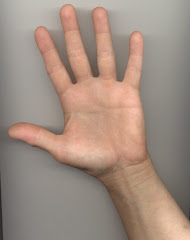The first litho did not turn out as it should have but I think I may be onto something that I noticed during the pouring of the soda over the plate. I talk a bit about it in the first video (posted below.) For anyone who does not have speakers on their computer (like I don't), basically I'm pointing out in the video a pattern that matched the pattern of flow the soda took on the initial pouring over the plate. The effect seems to be that the soda "over etched" and also may be eating out under the litho pencil marks. The pattern was in exactly the pattern the soda took on the initial flow over the plate. Hmmm.
NOTE: I had to post both videos onto facebook because they wouldn't load onto this blog host. Hope that doesn't create any problems for viewers.
In the second video, you see the plate being inked for my fifth print pull. I clean the plate between prints, using a little bit of vegetible oil and a soft cloth. I don't know if that's really necessary, but it does help me see the "print" areas (what the ink will be sticking to) on the plate. I like being able to see the quality of the lines and what marks are where. For example, there was a stray mark in the cat's right eye and during the first "roll up" with ink, I pushed the ink around that spot quite a bit with the sponge before I realized it was in fact a part of my original litho pencil drawing on the aluminum. Successive roll-ups reveal more and more of the actual drawing and I get a better feel for when the ink coverag is complete.
This second video is a bit longer. I haven't been able to get my video editing software to function quite right (yet.) In the beginning of the video you'll see that the image appears when I start the inking and then I essentially wipe it off. Well, actually I don't wipe it off; It only appears that way in the video. What I did was to wipe enough off so that I can see the "drawing" and how it is taking the ink. I've found that it helps me spot potential problem areas where I might need to not wipe so much or maybe need to deposit more or less ink with the brayer/roller.
https://www.facebook.com/profile.php?id=598509348&ref=tn_tnmn#!/video/video.php?v=10150484090474349¬if_t=video_processed












Well, I could not access your links. Something about permission needed to be granted. I am on Facebook also. If you have blogspot, you should be able to upload a short video. Set your video camera speed on the lowest speed setting. You will be able to record longer on your camera card. Anything over 100 megabyte will be too big to post.
ReplyDeleteHi Karl - Thanks for letting me know you couldn't view the videos. I think I found what the problem was and have corrected it. Please visit and re-try the videos.
ReplyDeleteCarol, Good job with the videos. There is nothing with letting it run like you did. I shows the whole process and gives attention to the care you give each print. There is nothing "instant" about it. Very good.
ReplyDeleteyour videos are a great help, i have started doing a few experiments with kitchlitho, and this is the first time i have had a chance to see the inking up process in detail. do you use etching ink, or litho ink? ty dave
ReplyDelete